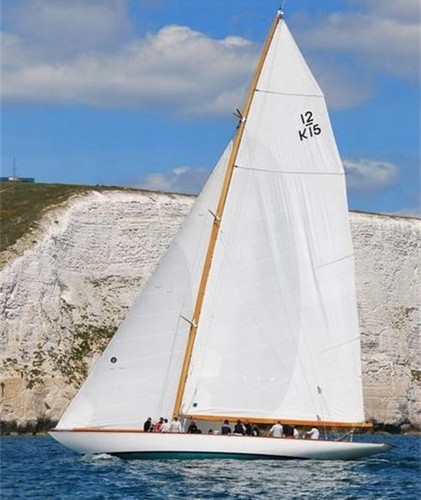British Classic Yacht Club Regatta at Cowes
by Justin Chisholm on 23 Jul 2008

British Classic Yacht Club Regatta - Wings - Photo © Nicky Aigner SW
Conditions on the Solent could not have been more perfect this morning for the start of the Round the Island race, on the first day of the 2008 British Classic Yacht Club Classic Regatta.
The forty-five classic yachts making up the regatta fleet were a marvellous spectacle, as under clear blue skies and in a ten to twelve knots northwesterly wind, they manoeuvred for optimum position on the Royal Yacht Squadron startline.
Classes Four, Three and Two got underway successfully and with a strong tide whisking them down the Solent, they were soon out of sight of the shore based spectators.
Attention then turned to the start of the five Class Zero yachts. Wary of being caught over the line too early, the skippers of these huge boats had to think carefully about their strategies. In the minutes preceding their start each of the boats could be seen making a number of timed practice runs.
At 09:40, with the beautiful three-masted, 212’ schooner Adix (mothership to The Lady Anne) watching closely from her nearby mooring, it was the 125’ Mariquita who led the fleet away towards the Eastern Solent at a remarkable speed of thirteen knots over the ground. The colossal sail plan on Mariette (138’) comprised no less than seven individually trimmed sails, as she powered across the line in close company with Kelpie (60’), The Lady Anne (98’) and the Yacht Club De Monaco’s Tuiga (92’).
The fleet of classic yachts made fast progress around the towards the check in point at St Catherine’s Point. With the breeze increasing at times to as much as eighteen knots, the crews were tested by the usual Round the Island Race challenges. Every headland and bay meant a decision whether to stay offshore or head in to try to find an advantage over the other boats. At St Catherine’s the fleet had compressed and the race team had their work cut out identifying the boats, taking times and acknowledging the boats radio transmissions.
Having led the fleet to the Needles, it was the 12 Metre Wings, racing in Class Two, who also made it home first, crossing the RCYC finish line shortly after five o’clock. Several minutes behind came Mariette closely followed by Mariquita and The Lady Anne. Several hours later the last of the fleet drifted over the line on the tide, in the dying rays of the sun, at just before nine in the evening.
Despite the long day on the water, the pontoons were full of smiles and stories about a great race. For the RCYC Commodore Tim Blackman at the helm of Infanta racing in Class Three the conditions were glorious for racing around the Island.
‘The sun was shining and we pretty much had wind all day. There were big gains and losses to be made based on your tactical decisions. At several points there were wind holes, which it was vital to avoid.
We got many things right but there also were times when we lost out to boats who had gone inshore when we had gone offshore or vice versa. When we got it right, for instance by skirting the edges of the ledges at one point, we took a great deal of time out of Ilderim and Lutine’. Infanta was the first boat home in her Class.
‘We are supposed to lead our fleet on the water’ commented Blackman. ‘Now it is just up to the mathematicians to establish how well we have done on handicap’.
Aboard the Class Zero boat Kelpie, bowman Adam Kaczor had an unwelcome incident to mark his twenty sixth birthday, when he was briefly knocked unconscious by the spinnaker pole. ‘I had been up on the bowsprit and moving back into the boat when suddenly the guy snapped and the pole fell very quickly. It caught me a glancing blow and knocked me out for a little while. I was soon back on my feet. Well I had to be – there wasn’t time for lying around!’
On David Murrin’s Cetawayo their race strategy appeared to have worked well. ‘We were in good shape from the off’ commented Murrin. ‘We were going well in Sandown Bay, got in close to the shore and took a ton of boats by using the back eddy. So much so that we were leading our class on the water as we came around St Catherines. We had a bit of a sticky patch when the wind dropped down below ten knots, which out boat doesn’t like too much. This let the Metre boats catch up. After that we set our running kite and headed for Yarmouth.
The breeze went quite tight and we ended up close reaching with the wrong kite but were still pulling away so we stuck with it. At Yarmouth we got the chance to peel to an asymmetric spinnaker and that was much better’. Murrin believes that sailing clockwise around the Island makes for a much more interesting race. ‘It’s very challenging. You need to think carefully about your entrances and exits to the obstacles. That’s where the big margins can be won or lost. Also going east about is good from a sentimental point of view. It’s how they used to do it and I think it is great for the classics to race that way around’.
Because of the late finish of the slower boats final results will not be published until Tuesday. Racing at the 2008 British Classic Yacht Club Regatta continues each day this week until Friday. Tomorrow Classes Two, Three and Four have a Ladies Race starting at 1100 from the Royal Yacht Squadron line. Class Zero take a day off tomorrow and will race again on Wednesday.
If you want to link to this article then please use this URL: www.sail-world.com/46757